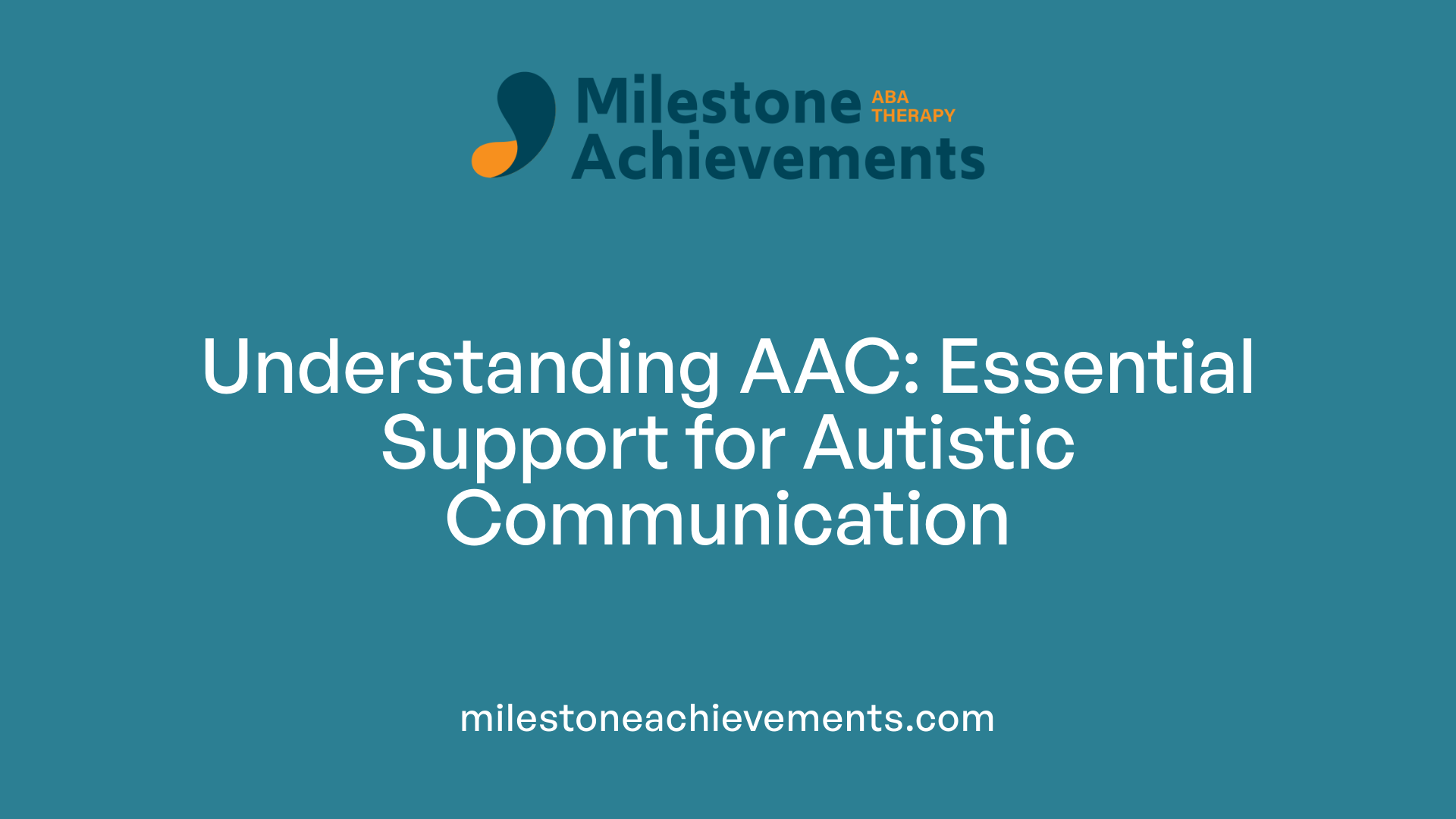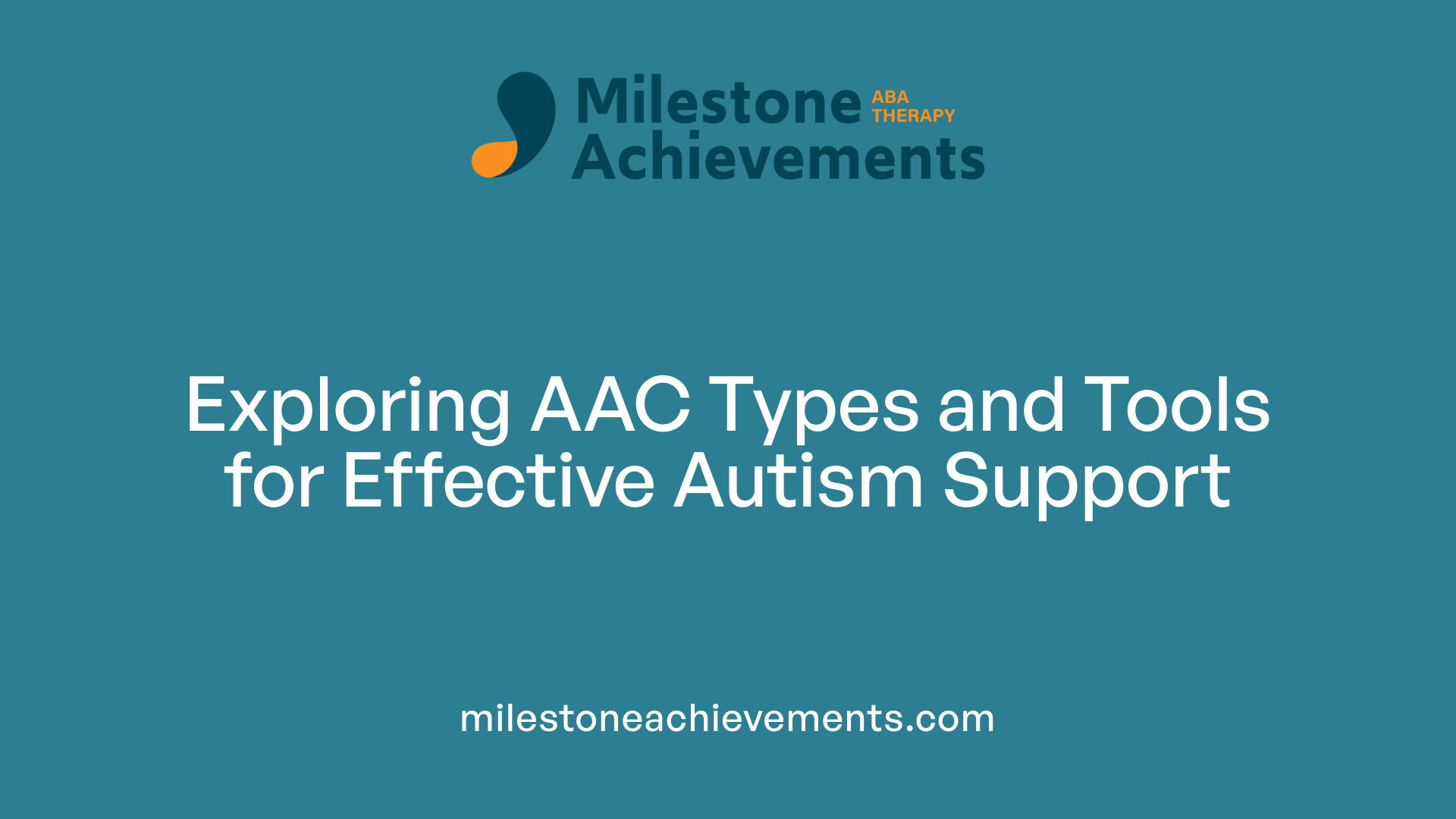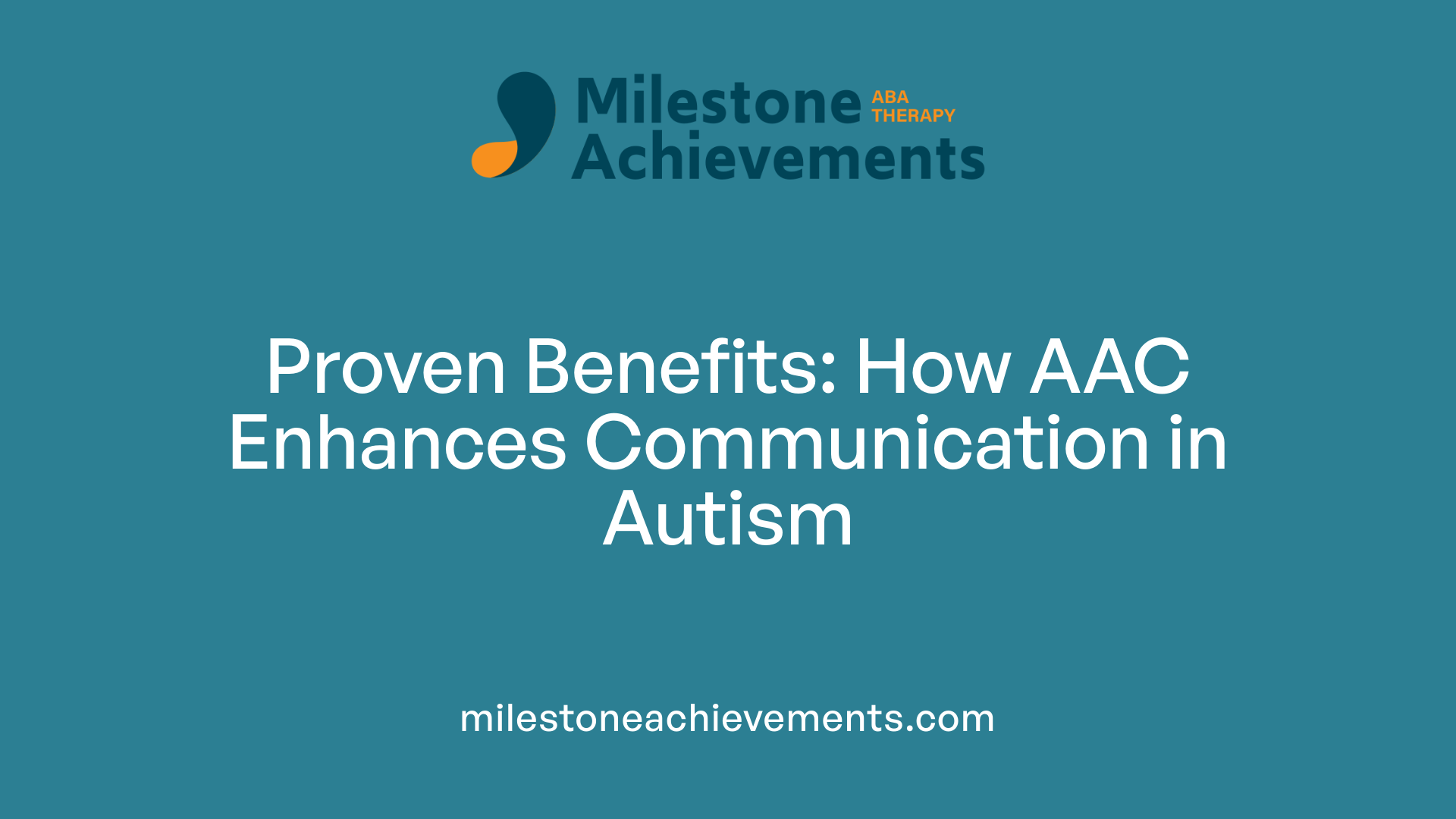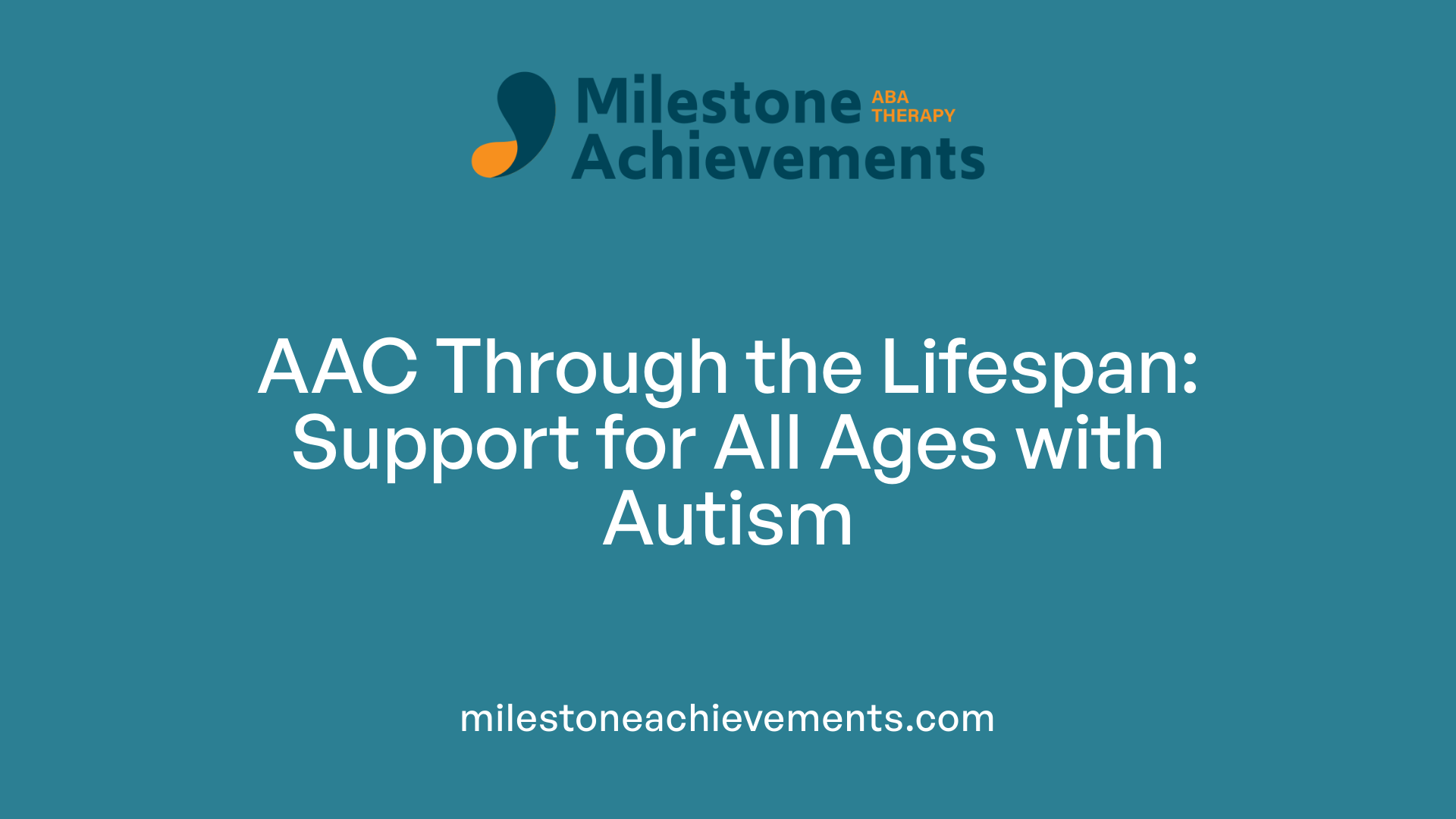
Using AAC for Autism Communication
Empowering Communication: The Role of AAC in Autism Support
Understanding AAC and Its Significance in Autism
Augmentative and Alternative Communication (AAC) encompasses a wide range of tools, strategies, and devices that support effective communication for individuals with autism spectrum disorder (ASD). Given that many autistic individuals experience challenges with verbal speech, AAC offers vital avenues for expressing needs, desires, and emotions, fostering social participation and independence. This article explores the types and applications of AAC, its benefits, implementation strategies, and insights from research and user perspectives, emphasizing the importance of personalized and inclusive communication approaches.
Defining AAC and Its Relevance to Autism

What is AAC and how it supports autistic individuals?
Augmentative and Alternative Communication (AAC) refers to a wide range of methods, tools, and systems designed to help individuals who have difficulty using spoken language to communicate effectively. For autistic people, especially those with limited or no speech, AAC offers vital ways to express their needs, feelings, and ideas. It includes both unaided approaches, such as gestures, facial expressions, and sign language, and aided methods, like picture exchange systems, communication boards, and electronic devices.
AAC plays a crucial role in enhancing social interactions, increasing independence, and reducing frustration. When used consistently, it helps children and adults with autism develop better communication skills, participate more actively in learning environments, and build stronger relationships. Early introduction of AAC supports not just immediate communication but also fosters inclusive opportunities in school and community settings.
Types of communication that AAC encompasses
AAC covers various modes of communication beyond spoken language. These include:
- Unaided Communication: Involving body language such as gestures, facial expressions, vocalizations, and sign language (e.g., ASL).
- Aided Communication: Using physical tools or electronic devices. This can be further divided into:
- Low-tech systems: Communication boards, picture cards, objects, and written symbols.
- Mid-tech systems: Devices like single-message communicators with buttons.
- High-tech devices: Sophisticated speech-generating devices like tablets and apps (e.g., Proloquo2Go, Tobii Dynavox).
These methods can be customized to meet an individual's motor skills, cognitive level, and personal preferences. For many autistic users, combining multiple forms of AAC enhances the clarity, flexibility, and effectiveness of their communication, ultimately supporting their inclusion and growth.
Types and Examples of AAC Used in Autism Support

What are common types and examples of AAC used for individuals with autism?
Augmentative and Alternative Communication (AAC) offers various methods to assist individuals with autism in expressing themselves and communicating effectively. These methods are broadly categorized into aided systems and unaided systems.
Aided AAC systems involve tools or devices that support communication. Common examples include picture-based systems like communication boards and PECS (Picture Exchange Communication System). PECS uses picture cards to teach requesting and expressing needs, making it especially useful for children who are beginning communicators.
Speech-generating devices (SGDs) are advanced high-tech options that produce spoken words, providing immediate verbal output. Examples of high-tech AAC devices include NovaChat, Via Pro, Tobii Dynavox, and Forbes AAC ProSlate. These devices typically feature touchscreens, customizable vocabularies, and options for eye-gaze or head-tracking, making them accessible for users with varying motor skills.
Low-tech AAC options include communication books, gestures, sign language, and facial expressions. These are often more accessible and may be used in conjunction with high-tech tools or independently, depending on the individual's needs.
Choosing the right AAC system depends on the person's abilities, preferences, and communication goals. Some individuals might benefit from simple picture cards, while others require speech-generating devices with sophisticated customization.
These systems support language development, facilitate social interactions, and can be adapted as the individual’s skills progress. The ultimate aim is to provide effective communication avenues tailored to each person's unique profile, helping foster independence and social participation.
Benefits and Evidence Supporting AAC Use in Autism

What are the benefits and effectiveness of AAC for individuals with autism?
Augmentative and alternative communication (AAC) offers a range of benefits for people with autism by enabling more effective communication through various methods such as visual supports, gestures, sign language, and electronic devices. AAC can be tailored to each individual, whether through simple picture cards or advanced speech-generating devices, ensuring personalized support.
Research has shown that AAC not only helps individuals express themselves but also supports the development of receptive language and literacy skills. It often reduces frustration and challenging behaviors by providing a reliable means for communication.
Early introduction and consistent use of AAC are crucial. Modeling AAC use, involving family and therapists, and providing ongoing training can foster spontaneous, meaningful interactions. This leads to increased independence, improved social participation, and greater confidence in expressing thoughts and needs.
Furthermore, AAC can support development across varied environments, including home, school, and community. Its role in promoting functional communication can significantly enhance quality of life, helping individuals with autism connect with others and participate more fully in everyday activities.
Overall, evidence suggests that AAC is a highly effective tool for improving communication and social skills in autism, supporting greater autonomy and social inclusion.
How does research support the use of AAC?
Multiple studies confirm that AAC devices and techniques do not hinder the development of spoken language; in many cases, they are associated with increased speech production. They serve as bridges to verbal skills, encouraging children to imitate sounds, words, and phrases.
Research also highlights that AAC can be effective across age groups—benefiting young children in early intervention and adults seeking to enhance independence. The use of AAC has been linked to better participation in social and educational settings, long-term skill development, and improved overall communication outcomes.
This growing body of evidence supports integrating AAC into comprehensive intervention programs, emphasizing a person-centered approach that respects individual preferences and abilities. The goal is not to replace speech but to provide additional means for effective interaction and learning.
Implementing AAC Strategies and Overcoming Challenges
How can AAC devices and strategies be implemented for individuals with autism?
Implementing AAC tools and techniques for autistic individuals requires a thoughtful, personalized approach. The first step involves assessment by specialists such as speech-language pathologists (SLPs), who evaluate the individual's communication needs, motor skills, and cognitive abilities. Based on this, appropriate AAC methods are selected, which may include low-tech options like picture exchange communication systems (PECS), communication boards, or high-tech devices such as speech-generating tablets.
Once a suitable device or system is chosen, comprehensive training is essential. This training not only involves the individual but also parents, caregivers, teachers, and other communication partners. They learn to model AAC use, reinforce communication attempts, and create opportunities for regular practice across daily routines and natural environments.
Integrating AAC into everyday activities helps promote generalization and independence. For example, using visual schedules and social stories supports understanding and predicts daily events, encouraging spontaneous communication. Environmental modifications, such as ensuring devices are accessible and durable, with customized settings like larger icons for motor difficulties, enhance usability.
Consistent use and ongoing support are vital for effectiveness. This includes regular therapy sessions, device adjustments, and encouragement to use AAC in various social contexts. As users become more familiar with their AAC systems, their communication skills can be further refined, fostering greater social participation and reducing frustration.
Involving professionals and family in AAC deployment
The successful deployment of AAC strategies hinges on collaboration among professionals, family members, and the individual. Speech-language therapists play a central role in assessment, choosing the right device, training, and follow-up. Occupational therapists might assist in adapting devices to motor abilities, while educators help embed AAC into classroom routines.
Family involvement is equally critical. Parents and siblings who are trained to model AAC and reinforce its use can greatly influence success. Providing guidance and support ensures device consistency at home and school, contributing to the child's confidence and competence.
Community engagement, like installing community-based communication boards, expands the usability of AAC beyond home and school. The entire support network should be committed to ongoing training, troubleshooting, and celebrating progress, ensuring these communication methods serve as empowering tools for individuals with autism.
Clinical research underscores that personalized, systemically supported AAC implementation promotes effective communication, independence, and social integration, ultimately enhancing quality of life for many autistic individuals.
Considerations and Challenges in AAC Selection and Use

What are some considerations, challenges, and factors to keep in mind when selecting and using AAC for autism?
Selecting appropriate augmentative and alternative communication (AAC) methods for individuals with autism requires careful planning and ongoing evaluation. One of the first steps involves a comprehensive assessment by a multidisciplinary team, which includes speech-language pathologists, occupational therapists, families, and the individuals themselves. This assessment considers personal factors such as age, cognitive ability, motor skills, sensory preferences, cultural background, language skills, and specific communication goals.
Device selection should match the individual's unique profile. For example, some may benefit from low-tech tools like picture boards, while others might require high-tech speech-generating devices or tablet apps. The vocabulary organization, symbolic representation, and access methods should be tailored to ensure usability and cultural appropriateness. Addressing potential challenges such as device costs, limited vocabulary options, or cultural mismatches is vital.
Cost is often a significant barrier; high-tech devices can be expensive, and funding or insurance coverage may be limited. To overcome this, families and practitioners need to explore available financial support and advocate for funding. Additionally, the relevance and cultural relevance of AAC symbols and content are crucial for meaningful communication.
Support and training are also essential. Successful AAC use depends on proper instruction for users, families, and communication partners. Training should cover how to operate devices, include modeling usage, and create opportunities for the individual to practice communication skills confidently.
Environmental modifications can enhance AAC effectiveness. This may involve arranging physical spaces to reduce sensory overload or ensuring devices are accessible in various environments like home, school, and community settings.
Systemic barriers, such as lack of access to trained professionals or limited community resources, can impede progress. Continuous system adjustments and personalized support help maintain user engagement and developmental gains.
Advocacy is necessary to raise awareness about the importance of AAC and to secure necessary resources. Ensuring equitable access involves promoting policies that support funding, training, and community integration.
In summary, selecting and using AAC for autism involves weighing individual needs against practical challenges, fostering supportive environments, and advocating for resources. This comprehensive approach ensures that AAC tools truly serve as effective, meaningful communication partners for those on the autism spectrum.
Supporting All Ages with AAC: From Childhood to Adulthood

Are AAC devices and methods suitable for both children and adults with autism?
Absolutely. AAC, or augmentative and alternative communication, is designed to be adaptable to all age groups, serving children, adolescents, and adults with autism. These communication systems can be tailored to the individual’s unique needs, abilities, and preferences, enabling effective communication throughout their lifespan.
For children, AAC tools like picture exchange cards (PECS), visual schedules, and beginner-friendly speech-generating devices help facilitate language learning and social interaction. As they grow, these systems can evolve, incorporating more advanced technology such as tablets with specialized AAC apps like Proloquo2Go or Tobii Dynavox devices. This supports the development of complex language skills, independence, and social integration.
For adults, AAC continues to play a vital role, especially for those who experience ongoing speech or language challenges. Electronic speech-generating devices, mobile apps, and customizable communication boards help adults to express needs, participate in social activities, and maintain employment. Many adults with autism find that AAC tools reduce social anxiety and increase confidence.
Personalization is crucial. Each individual’s system is adjusted for their motor skills, cognitive level, and communication goals. Devices can be modified with features such as larger buttons or highlighted keys for those with motor difficulties, or visual and auditory feedback to support comprehension.
The use of AAC throughout the lifespan ensures continuity of support. It can be introduced at any age, regardless of current speech abilities, and can be used temporarily or permanently, depending on the circumstances. Collaboration with speech-language pathologists and caregivers is essential to tailor interventions effectively.
In summary, AAC is a versatile approach suited for all ages. It offers a comprehensive framework for supporting the communication needs of autistic individuals as they develop and age, fostering independence and enriching social participation.
Fostering Inclusive Communication for a Better Future
The integration of AAC into the lives of individuals with autism offers transformative potential—creating pathways for expression, social connection, and independence. Recognizing that each person’s needs and preferences vary, it is essential to emphasize personalized assessment, family and professional involvement, and continued research to maximize AAC’s effectiveness. As technology advances and societal understanding deepens, AAC remains a vital field dedicated to empowering individuals with autism, challenging societal ableism, and promoting participation across all areas of life. Embracing AAC not only enriches individual lives but also advances a more inclusive, understanding society where everyone’s voice can be heard and valued.
References
- What is Augmentative and Alternative Communication and how can ...
- Why AAC? - The Center for AAC & Autism
- AAC Interventions for Individuals with Autism Spectrum Disorders
- Technology and Autism | Autism Speaks
- Should All Nonverbal Young Children with Autism Immediately Have ...
- “Everyone Deserves AAC”: Preliminary Study of the Experiences of ...
- AAC: Augmentative and Alternative Communication for Autism


Partner with us on your child's journey
Milestone Achievements offers evidence-based ABA therapy to help children with autism reach their full potential. Together we’ll set meaningful goals and celebrate progress every step of the way.
Start ABA Services Today


